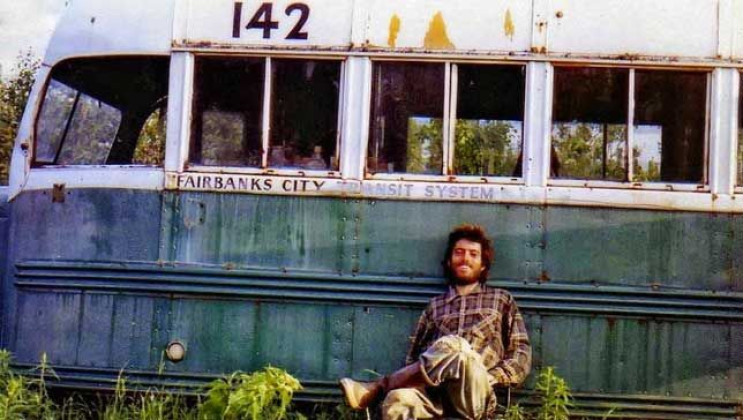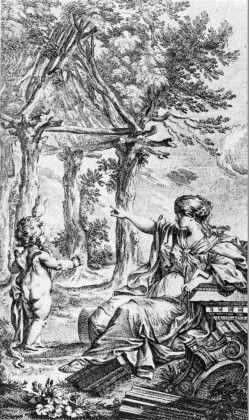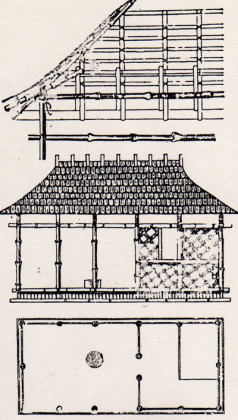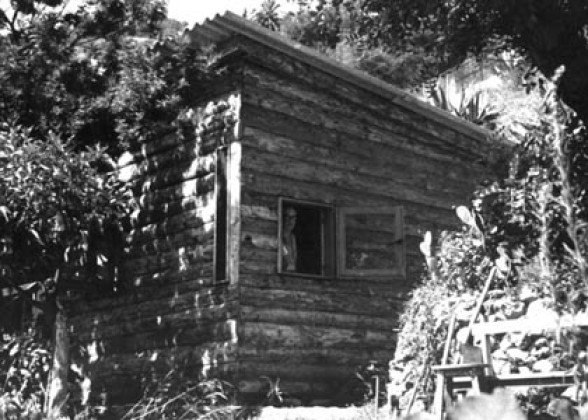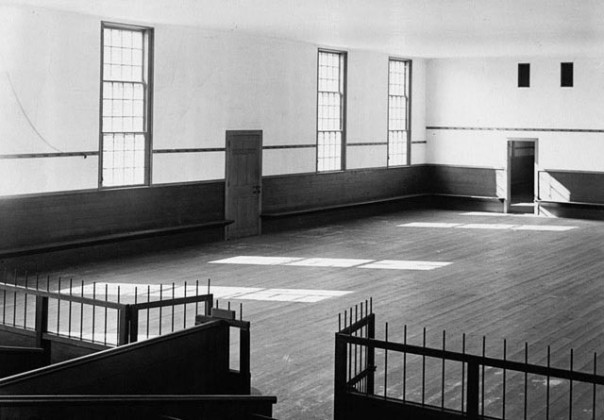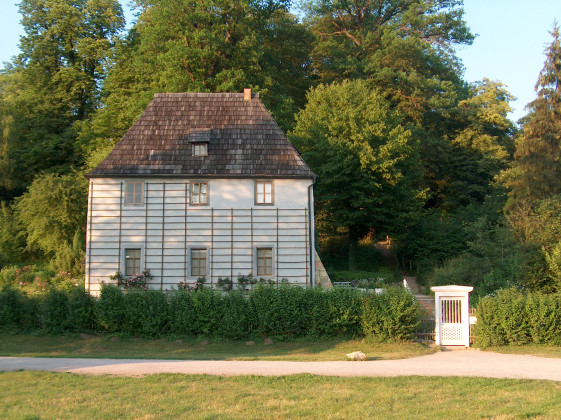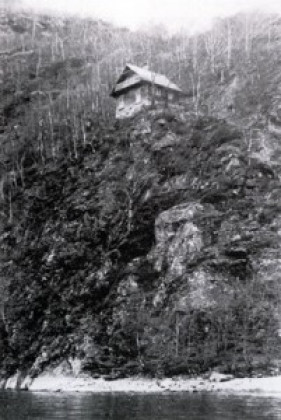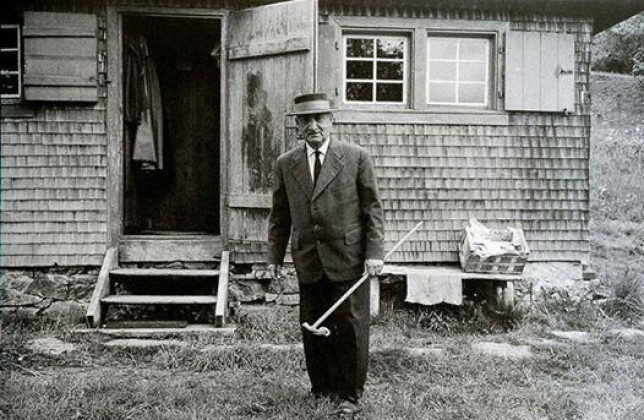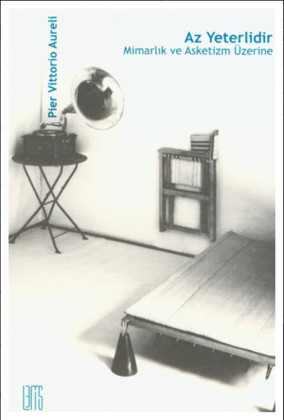The Way of the Modern Barbarian: On Pier Vittorio Aureli’s 'Less is Enough: On Architecture and Asceticism'
Society
It's a mystery to me
We have a greed
With which we have agreed
You think you have to want
More than you need
Until you have it all, you won't be free
Society, you're a crazy breed
I hope you're not lonely without me
When you want more than you have
You think you need
And when you think more than you want
Your thoughts begin to bleed
I think I need to find a bigger place
'Cause when you have more than you think
You need more space
Society, you're a crazy breed
I hope you're not lonely without me
Society, crazy and deep
I hope you're not lonely without me
There's those thinking more or less less is more
But if less is more how you're keeping score?
Means for every point you make
Your level drops
Kinda like it's starting from the top
You can't do that
Society, you're a crazy breed
I hope you're not lonely without me
Society, crazy and deep
I hope you're not lonely without me
Society, have mercy on me
I hope you're not angry if I disagree
Society, crazy and deep
I hope you're not lonely without me
Jerry Hannan
Prologue
Released in 2007, the Sean Penn-helmed Into The Wild uses the song "Society" - Jerry Hannan's lyrics sung by Eddie Vedder - to give voice to the motivations behind, and the outcomes of, a protagonist’s individual choice to leave the way of life imposed by the modern society that produces and consumes more than it needs; a society that bases its ethos on possession, and worst of all, reduces “less” to an aestheticized instrument to possess more; through the struggles of a protagonist who chooses to become an ascetic by doing with less; who aspires, thereof, to obtain his freedom. The subject of the movie was the real life story of the 23-year-old Christopher McCandless, who broke free of all his economic, familial and social ties, and began to live in an abandoned bus in the middle of the Alaskan wilderness. The price he paid for his escape to nature, away from society, was his own life; he died after four months spent in the wild. The reason why I recall this “modern barbarian”, who attempted to put his own way of living at the center of his daily practices to transform his ego, is Pier Vittorio Aureli’s book Less is Enough: On Architecture and Asceticism. The book, translated to Turkish and published by Lemis Publishing in 2015, brings forward a critical approach against the fact that asceticism becomes a trend in architecture; especially at times of crisis.
Less was (is) Pleasure
“Oh soul, thou shall fall into a trouble where the remedy is hidden
Fall into a drop wherein the ocean is hidden
Leave thy earthly life and wear the gown of remise
In that gown is the sultan’s secret hidden
From the poems of Eşrefoğlu Abdullahi Rumi, ode to İsmaili Ma’şuki1
Asceticism means “renunciation of the world and its pleasures in order to devote oneself completely to religion, extreme piety, extreme self-denial, seclusion and humiliation of the spirit”. Aureli starts to trace asceticism in ancient thinkers who advocated a life which merged theory and practice, logos and bios; while criticizing, from their perspectives, the social and political conditions of their times. The ancient times were an era when renunciation of earthly pleasures was considered to be the way to freedom from material and social constraints; and the way to comprehend the secrets of the soul. Aureli then moves on to monasticism, which denied the union of Christian belief with institutions of power; and to the monastery as the spatial and temporal organization of monasticism. Asceticism was secularized in modern era, and crystallized in Protestant ethics, paving the way for the foundation of the ethics of work and production in the spirit of capitalism. Aureli suggests that the monastery is the precursor of the amendatory institutional typologies of the modern age, such as the prison, the military post, the hospital, and the factory. In this process, private property and accumulation become means of power, and asceticism, ceasing to be an individual choice to construct an autonomy against power, transforms into an ethos that imposes more work, more production, more accumulation and more consumption: an ethos which enables social discipline, and legitimizes the capitalist status quo. Exactly at this point, however, according to Benjamin, emerges another sort of asceticism that offers an opportunity to transform the deterritorialization and precariousness in the modern society, where abundance of objects and information in the metropolis results in the lack of experience, into a form of freedom. This is the asceticism of the “modern barbarian”, as personified in Charles Baudelaire’s writings, wandering aimlessly in the streets of the metropolis, refusing to work; doing with less for a longer time, and experiencing, directly, the chaos of the metropolis as a work of art itself. Boris Pasternak writes in his 1957 novel “Doctor Jivago” that “the two basic ideals of modern man - without them he is unthinkable” are “the idea of free personality and the idea of life as sacrifice.” One aspect of the asceticism of the modern barbarian leads to the discovery of the city as in the flâneur, the dandy, and the situationist; while the other leads to the motivation of some poets and thinkers to search for meaning and order2 in their hermitages innature, separated from the society and from the city.
Adam’s House in Paradise
“There exists no piece of wood, no sole girder, which does not have a special function in terms of shape and strength. Man economizes. Cannot this hut, one day, become a Roman Parthenon devoted to gods?”
Le Corbusier, A House, A Palace, 1928
At this point, Aureli’s work could be taken as an opportunity to reconsider the role of the primal hut in the theory and history of architecture. In the essay entitled “On Architecture”, the field’s first theoretical text, the hut is mentioned; Vitruvius claimed that the construction of a hut was an inevitable outcome of the invention of language, and of the birth of social relations. Naturally, he could not have guessed that the modern barbarians would transform the hut into an architectonic symbol of the voluntary withdrawal from sociality and communication at a time of abundance of objects and information, and lack of experience. After Vitruvius, in the 15th century, Filarete used Adam’s figure, expelled from paradise, covering his head over with his arms, as a representation of the building practice of the hut; and this religio-mythical character lasted until the 18th century. According to Rykwert, as a result of Adam’s gesture, the hut becomes the earthly projection of his house in Eden. However, in “An Essay on Architecture”, penned in 1755, Marc-Antoine Laguier secularized the primitive hut as the natural, original model of architecture, and as the representation of pure construction without any ornamentation. This hut, considered as the beginning of architecture in western canon, consists of four tree trunks; and branches, leaning towards each other, joining the trees together3. A century later, Gottfried Semper, who defined the four basic elements of architecture as hearth, roof, enclosure of space, and a ground of earth, came out against Laugier’s natural model with an anthropological anti-thesis that referred to a Carribean hut. Before the Second World War, a romantic conservative, Paul Schmitthenner, argued against the modernist resident experience in Weissenhof, as well as against the transformation of the house into a machine; and chose instead, as the prototype of ideal German house - spiritual, moral, and modest - Goethe’s house by the river Ilm, in Weimar; thus turning the hut into a basic element in the construction of a national identity. On the other hand, Le Corbusier, aiming to remain only with nature, to explore the wild and primitive aspects of his soul, and to retrace the basics of architecture, built in 1952 a hut called “Le Cabanon” by the Mediterranean Sea; a microcosmic spatial experience based on the Modulorian measures and ratios. Le Corbusier believed his experiment proved that the bareness of a simple hut was much closer to the sublime truth than any of the architectural splendors.
Escape to Nature as a Form of Modern Barbarism
“I went to the woods because I wished to live deliberately, to front only the essential facts of life, and see if I could not learn what it had to teach, and not, when I came to die, discover that I had not lived.”
Henry David Thoreau, Walden,or Life in the Woods, 1854
Placed within the modern society, believing life cannot be experienced amidst the chaos of the metropolis, the modern barbarian believes that the existential crises can only be overcame by coming in contact with the purest form of reality4; and that the answer in the search for meaning5 will be found only in a self-absorbed, ascetic escape to nature. With his line, "We do not know where we are", the puritan and ascetic Henry David Thoreau, the most significant representative of the 19th century American transcendentalist poetry, refers to the irrelevancy of place and existence. In order to learn where man stands in terms of both physical and metaphysical being, he built a wooden hut of 3 by 4.5 m in size, in Concord, Massachusetts; in the forest by the Walden Lake. He lived there in seclusion for two years, two months and two days. Thoreau’s hut was not a stylistic example of a “less is more” minimalism but the space of a minor life where less was truly enough. In his hut, Thoreau read the natural world, which he saw as an expression of language; and based his discourse on his experience with the physical environment. His hermitage away from the metropolis and technology was a poetic space of naturalist and romantic resistance, of “euphoria and melancholia”6, in which the independency in building one’s dwelling place, and in transcendental explorations of the spiritual and intellectual kind, emerged. In this context, Thoreau’s hut as an architectonic expression of the American “do-it-yourself” ethos is, in a simultaneous nature, at the intersecting point of the Heidegerrian junction of poiesis, residing, and building.7 Yet this self-sufficiency also meant a moderate subjection to a transcendental context that surpasses the human subject, and holds it to the natural order. Moreover, this particular form of American asceticism that is adjacent to the wild nature - especially in the western states of the country - offered the opportunity to set free from the national identity construction, from the search for historical roots, and from the hierarchical social structure. As Deleuze and Guattari8 suggest, in America, directions are not only different, but also inverted. “Tree” as the representation of hierarchy and origin was traced in the east, while members of the beat and the underground literary movements9 found their escape in the desolate and eternal nature of the rhizomatic and ascetic natives who were free from ancestors and nobility. The search for transcendence, which the old world directed towards the east, was thus transferred to an immanency hidden in the wild nature of the west.10
In the House of Poetry and Philosophy
“The dislocation of man back into his ground has to be carried out in the first place by those few, solitary, and uncanny ones, who in various ways as poets, thinkers, as builders and artists… (who) ground and shelter the truth of Being...”
Martin Heidegger, Basic Questions of Philosophy: Selected Problems of Logic, 1937-1938
The primal hut as the space of the ascetic life may be seen as reflected in the barrel of Diogenes of Sinope, who used to live with dogs, free from social values, in the utmost minimal physical conditions; advocating for self-sufficiency. Diogenes, upon seeing a boy drinking from a well by the use of his hands, shattered his only possession - a wooden barrel. The great haiku master Matsuo Basho Kinsaku wrote his haikus, themselves supreme proof that less is enough; in his hut which he called “minomushian” (the hut of the moth), and which was built by his disciples on a desolate spot by the Sumida river. Goethe, the German thinker and poet, worked in his hut in Weimar, by the river Ilm. In modern era, two thinkers come forward as those who had the courage to take the desolate asceticism of a hut in nature, right at the very center of their lives. Ludwig Wittgenstein escaped from family traumas, from the 20th century Viennese decadence, the artificiality of human interactions, the endless conflict between resistance to and accordance with the bourgeois life, and from the academic circle in Cambridge, which he criticized as a society of reciprocal admiration11. In 1914, he moved to a hut he had built on a hill in the village Skjolden, by a lake in Fjord Sogne, in the west of Norway. There, he worked very efficiently on his masterpiece, Tractatus Logico-Philosophicus12. The totalitarian aspect of the ethical challenge of Wittgenstein’s puritan13 character rises upon the unmerciful nature of the wilderness surrounding the hut, a nature such that is caused by an unrevealing god14. Martin Heidegger, influenced by the German romantic provincialism, moved to a hut out on the skirts of Todtnauberg Mountain in the Black Forest area of southern Germany, and worked there until his death15. He named this hut “Hütte”. It was 6 by 7 meters in size; a three-roomed, moderate, minimally furnished, traditional, wooden hut. “Hütte”, with its virtues of privacy, introversion, moderation, integrity, submission and sobriety16, was not only a frontier of resistance against the transparent, uncanny, and fragmented modern dwelling; but also the very threshold where existence17 resided, between nature and architecture, between thinking and building, between the metaphysical and the physical, between the psyche and physis, between poiesis18 and reality - between transcendence and immanence.
Has Modern Architecture Followed Religious Asceticism?
“I had three chairs in my house; one for solitude, two for friendship, three for society. When visitors came in larger and unexpected numbers there was but the third chair for them all, but they generally economized the room by standing up.”
Henry David Thoreau, Walden, or Life in the Woods, 1854
Whereas the American west is the geography of escape to nature for the modern barbarian’s rhizomatic life experience that is immanence in worldliness, the country’s east is the topos of the search for transcendence through a religious asceticism, not as an individual choice, but as a community-building process based on the utopia of returning to the old world. This topos was at the end of the 17th century under the influence of Quakers, who built settlements in northeast America, and named them by adding “New” to cities referred to in the Old and New Testaments, and from the second quarter of the 18th century on, the Shakers took over in New England, Kentucky and Ohio. Quaker treatise, representing the extreme left wing of the British puritanism, aimed at establishing the ideal church with a communal view of life. It emphasized the comprehension of God through an inner experience; it opposed orthodox beliefs, clergy officials and church institutions. Without any prior preparation and without any clergyman, Quakers got together quietly for religious services, and expected God to choose one of them as the clergyman of that particular service - the nominee used to shake uncontrollably when chosen. This practice was far out of orthodox rules. In daily life, Quakers were in support of quietism, pacificism; they were in opposition to war, slavery and death penalty, and they strived for an asceticism that included leaving oneself wholly to God in a bid to destroy the self. Shakers devoted themselves to a communal life; to ascetism, intense worshipping, avoiding wastefulness, collaboration and sharing, and adopted three basic principles to shape their daily lives: celibacy19 (prohibition of marriage and sex among members of the cult), charity and communal economy. They took Jesus’ poorness as a model, and considered work as sacred, as a form of worship. Such an ascetic way of life resulted in a simple, undecorated, functional aesthetic approach to whatever they built - from furniture to commune houses, from clothing to the compounds. They shied away from the external world, and aimed to build an earthly paradise in economically self sufficient settlements, free from ornamentation and unnecessary details, with pragmatic and functional interiors. In this context, it is impossible to see it as a coincidence that the Chicago School, as the creator of the modernist slogan “form follows function”, was established in Indiana, where Shaker asceticism was widespread.
Epilogue
“If this adventure proves fatal and you don’t ever hear from me again, I want you to know you’re a great man. I now walk into the wild.”
Christopher McCandless, last postcard to Wayne Westerberg
The asceticism of the modern barbarian, the path of escape from social order and hierarchy and from the capitalist production, emerges, in terms of an architectonic reality, as the hut in the wilderness. This model, in favor of the rhizomatic eastern steps, deserts, and oases, can be considered as an alternative “rhizomatic forest” model to the “tree”20 model which is dominant in the western thought; which symbolizes the agricultural production transforming the forest into a plantation. Today, with the “less is more” formula becoming an aesthetic problem in a purely stylistic representation, the “less is enough” formula corresponds to an ethical problem as “the subject’s self education to live in accordance with self-proclaimed principles, in a continuous awareness of mind and body”21. This process of education almost always withholds the subject from interaction with other bodies, and will clearly allow - unless the subject stuck wandering in the metropolitan chaos - interaction with the “real world”22. In the words of the ascetic poet and stonemason John Robinson Jeffers, who built the Tor House and the Hawk Tower where he took shelter, an asceticism of this sort is only achievable for “a few dead men who have the same temper with the mountains.”
Wise Men in Their Bad Hours
… Death’s a fierce meadowlark: but to die having made
Something more equal to the centuries
Than muscle and bone, is mostly to shed weakness.
The mountains are dead stone, the people
Admire or hate their stature, their insolent quietness,
The mountains are not softened or troubled
And a few dead men’s thoughts have the same temper.
John Robinson Jeffers23
Notes
1 Gölpınarlı, Abdülbaki. Melamîlik ve Melamîler. GriYayın, İstanbul, 1992. p. 351.
2 In Solitude: A Return to the Self (1988), Anthony Storr reflects on the relationship between the creativity of a person and the avoidance from social relations, claiming that seclusion is a search for meaning and order: “It is true that many creative people fail to make mature personal relationships, and some are extremely isolated. It is also true that, in some instances, trauma, in the shape of early separation or bereavement, has steered the potentially creative person toward developing aspects of his personality that can find fulfillment in comparative isolation. But this does not mean that solitary, creative pursuits are themselves pathological. Avoidance behavior is a response designed to protect the infant from behavioral disorganization. If we transfer this concept to adult life, we can see that an avoidant infant might very well develop into a person whose principal need was to find some kind of meaning and order in life which was not entirely, or even chiefly, dependent upon interpersonal relationships.” (Storr, as cited in: Krakauer, Jon. Into the Wild. Anchor Books, 2007.) On the other hand, Theodore Roszak, in his “In Search of the Miraculous”, states that seclusion is not suitable for those who do not have creative capacities: "It may, after all, be the bad habit of creative talents to invest themselves in pathological extremes that yield remarkable insights but no durable way of life for those who cannot translate their psychic wounds into significant art or thought." (Roszak, as cited in: Krakauer, Jon. Into the Wild, Anchor Books, 2007.)
3 Laugier, in the same work, signals that man can find a house on earth inside the primitive hut: “He wants to make himself a dwelling that protects but does not bury him. Some fallen branches in the forest are the right material for his purpose; he chooses four of the strongest, raises them upright and arranges them in a square; across their top he lays four other branches; on these he hoists from two sides yet another row of branches which, inclining towards each other, meet at their highest point. He then covers this kind of roof with leaves so closely packed that neither sun nor rain can penetrate. Thus man is housed.”
4 Paul Shepard, in his Man in the Landscape: A Historic View of the Aesthetics of Nature (2002), highlights the metaphysical aspect of experiences under difficult conditions in nature: “To the desert go prophets and hermits; through desert go pilgrims and exiles. Here the leaders of the great religions have sought the therapeutic and spiritual values of retreat, not to escape but to find reality.” (Shepard, as cited in: Krakauer, Jon. Into the Wild. Anchor Books, 2007.)
5 In his last letter to his brother Waldo on November 11th, 1934, Everett Ruess justifies the seclusion of the individual who experiences difficulty in sharing with society: “Do you blame me then for staying here, where I feel that I belong and am one with the world around me? It is true that I miss intelligent companionship, but there are so few with whom I can share the things that mean so much to me that I have learned to contain myself. It is enough that I am surrounded with beauty...” (Ruess, as cited in: Krakauer, Jon. Into the Wild. Anchor Books, 2007.)
6 Roderick Frazier Nash, in Wilderness and the American Mind (1967), explains the relationship between the romantic spirit and the wilderness as such: “Wilderness appealed to those bored or disgusted with man and his works. It not only offered an escape from society but also was an ideal stage for the Romantic individual to exercise the cult that he frequently made of his own soul. The solitude and total freedom of the wilderness created a perfect setting for either melancholy or exultation.” (Nash, as cited in: Krakauer, Jon. Into the Wild. Anchor Books, 2007.)
7 In Walden, or Life in the Woods (1854) Thoreau explains how he started building his hut: “I borrowed an axe, went down to the woods by Walden Pond, nearest to where I intended to built my house, and began to cut down some tall arrowy white pines, still in their youth, for timber.” For Thoreau, the hut, as the space of ascetic life and production merged the natural and the poetic. He writes: “There is some of the same fitness in a man's building his own house that there is in a bird's building its own nest. Who knows but if men constructed their dwellings with their own hands, and provided food for themselves and families simply and honestly enough, the poetic faculty would be universally developed, as birds universally sing when they are so engaged?”
8 Deleuze, Gilles and Félix Guattari. A Thousand Plateaus - Volume 2 of Capitalism and Schzophrenia. Translated by Brian Massumi, Continuum Books, London and New York, 2008. p. 21.
9 “Don't go for the root, follow the canal” sings Patti Smith, musician and poet. “I have got to leave to find my way / … The privileged and weary eyes / Of river poet search naiveté,” as the REM song goes; talking of seclusion and a place of pure reality in an untouched nature. Almost all American avant-garde glorifies the ascetic experience of the individual in wilderness.
10 Wallace Stegner, in his book The American West as Living Space (1987), depicts the American west as the place of escape and as the place for the search for freedom: "It should not be denied that being footloose has always exhilarated us. It is associated in our minds with escape from history and oppression and law and irksome obligations, with absolute freedom, and the road has always led West." (Stegner, as cited in: Krakauer, Jon. Into the Wild. Anchor Books, 2007.)
11 When Wittgenstein decided to leave his brilliant academic career to live in solitude in a fjord in Norway, his professor of logic and philosophy in Cambridge - the great thinker Bertrand Russell - tries to change his pupil’s mind. In his letter to Lucy Donnelly, written on October 19th, 1913, Russell writes: “I said it would be dark, and he said he hated daylight. I said it would be lonely, and he said he prostituted his mind talking to intelligent people. I said he was mad and he said God preserve him from sanity. God certainly will.”
12 In a letter to Russell in 1914, Wittgenstein wrote: “… now I am building myself a small house here miles away from anyone.” He also wrote to him one of the first ideas that came in that hut: “… the whole of logic follows from one primitive proposition.” This idea emphasizes the importance of simplicity and essentiality.
13 Two years prior to moving into the hut, Wittgenstein had read the American psychologist and thinker William James’ 1902 book The Varieties of Religious Experience: A Study in Human Nature, on the experiences of seclusion of Buddha, Tolstoy and Thoreau in nature. On the other hand, it was probably that very hut that he developed his ideas on the similarity of philosophy and architecture, and on the work of philosophy as one’s perception of the self and of objects. Expectedly, Wittgenstein, in collaboration with Paul Engelmann, a disciple of Adolf Loos, built a house for his sister in Vienna in 1928; a house which some critics interpreted as “logic in the form of a house”. In this context, Wittgenstein’s hut, with its precision, purity, austerity, and silence, can be considered as a “house in the form of logic”.
14 Henrik Ibsen, the Norwegian playwright, reflects on the impact of cruel natural and climatic conditions, as well as the obligatory ascetic life, on the souls of northern people: “He who wishes to understand me, must know Norway. The magnificent, but severe, natural environment surrounding people up there in the north, the lonely, secluded life - the farms are miles apart - forces them to be unconcerned with others, to keep to their own. That is why they become introspective and serious, they brood and doubt - and they often lose faith. At home every other person is a philosopher! There, the long, dark, winters come with their thick fogs enveloping the houses - oh, how they long for the sun!”
15 The foundation of human existence is “being in the world” and “being toward death”, according to Heidegger, who penned a majority of his Being and Time (1927) inside his hut. In his article “Why Do I Stay in the Provinces?”, Heidegger explains that what was to the outsiders loneliness, was to him a sense of isolation that allowed him to experience the entirety of existence, and to turn into a being: “This is my work-world. … Strictly speaking I myself never observe the landscape. I experience its hourly changes, day and night, in the great comings and goings of the seasons. … all of this moves and flows through and penetrates daily existence up there, and not in forced moments of “aesthetic” immersion or artificial empathy, but only when one’s own existence stands in its work. … But it isn’t loneliness, it is solitude. … Solitude has the peculiar and original power not of isolating us but of projecting our whole existence out into the vast nearness of the presence of all things.” Immersed in the impressive nature, the moderate hut does not catch the eye within the spectacular landscape. The hut for the thinker is not a romantic place from which to watch the landscape, to be enchanted by the picturesque sights, and experience aesthetic affections; it is, instead, the place to penetrate into the natural cycles such as day and night, or the changing of seasons; to work like a farmer by cutting woods, drawing water from a well, and in the remaining hours, to think, to write, and to walk. When Heidegger is in his hut, he comes closer to the submissive moods of the faithful and moderate people; people who do not know any other than their own world, who do farming and housework, who speak the language of the nature, who live in tight family relations and strict social structures. This experience helps him to come up with the idea of “releasement”, a sort of fatalism that refers to a sense of “being” that does not force the conditions of distancing it the essence.
16 According to Heidegger, through poetry, man measures his being beneath the skies and above the earth against the divine. The divine is the scale by which man measures out his dwelling, his place of occupation on earth, beneath the skies. Whenever man commits to that measuring, he is within poetry. The modern lifestyle however made it impossible to recognize the absolute necessity of such measuring. The one who uses such a measure despite everything, becomes alienated from the society, labeled as mad, criminal, pervert, or marginal. When it was understood that this poetry could be used as a commodity, it become imprisoned in the cool aura of intellectual consumption, not in the unity of mind and body, in an extraordinary artistry. Heidegger refers to poetry as what keeps man within this measuring, which clarifies his existentialist nature. When man dwells poetically, he is the subject to this measure, which keeps him in submission; releasement and modesty before the divine. The life in the hut is submitting oneself to this measurement. The poetical is not in the aura of the “less is more” discourse, or in the minimalist aesthetics; but in man staying within the perimeters measured for him by the divine.
17 According to Heidegger, man lives within a fourfold structure, which constitutes the unity of its origin. This fourfold is his sphere of being, which makes it possible to measure man himself against the universe, rather than leaving him as an isolated, wandering creature. In his 1951 essay “Building Dwelling Thinking”, Heidegger explains the idea of the fourfold as follows: “Earth is the serving bearer, blossoming and fruiting, spreading out in rock and water, rising up into plant and animal. … The sky is the vaulting path of the sun, the course of changing moon, the wandering glitter of the stars, the year’s seasons and their changes, the light and dusk of day, the gloom and glow of night, the clemency and inclemency of the weather, the drifting clouds and blue depth of the ether. … The divinities are the beckoning messengers of the godhead. …The mortals are the human beings. They are called mortals because they can die. To die means to be capable of death as death. Only man dies, and indeed continually, as long as he remains on earth, under the sky, before the divinities.” Only the one who is capable of death as death can be considered as lived a living. The hut in the nature, which challenges the philosophical wordplays, i.e. aesthetics and empathy, is the dwelling place for its builder, who preserves and experiences the essence of the fourfold.
18 Heidegger argues that existence is in the poesy of man’s life on earth. His thoughts on poetry and dwelling are crystallized in his 1954 essay “… Poetically Man Dwells”. The phrase is taken from a late poem by the romantic poet and founder of German idealism, Friedrich Hölderlin, which begins with, “In lovely blueness blooms the steeple with metal roof…” According to Hölderlin, poetry is the only thing capable of imitation of what is whole, since it includes not only what is possible, but also what is impossible. Hölderlin’s father and stepfather had passed away when he was still a child. After completing his education at a seminary, Hölderlin befriended Hegel and Schelling. He tended to stay isolated from the society, in a continuous melancholic mood, taking shelter with his mother following all his traumas. What is rumored to be the cause behind Hölderlin’s accelerating route to a nervous breakdown is his incapability of uniting with his lover, a married woman, who responded to his feelings in kind, but was incapable of truly living with him. The critiques believe that the lover which he calls Diotima in his poems, named after the woman who shows Socrates what real love is, was Hölderlin’s one true love. Struggling with bad moods and anger issues, Hölderlin spent his last 36 years following the breakdown in solitude in a tower (or in a hut!) in a carpenter’s dwelling.
19 Thoreau, who lived a bachelor’s life until his death, goes beyond the idea that less is enough: “The greatest gains and values are farthest from being appreciated. We easily come to doubt if they exist. We soon forget them. They are the highest reality. Perhaps the facts most astounding and most real are never communicated by man to man. The true harvest of my daily life is somewhat as intangible and indescribable as the tints of morning or evening.” (Thoreau, as cited in: Krakauer, Jon. Into the Wild. Anchor Books. 2007)
20 Deleuze, Gilles and Félix Guattari. A Thousand Plateaus - Volume 2 of Capitalism and Schizophrenia. Translated by Brian Massumi, Continuum Books, London and New York, 2008. p. 20.
21 Aureli, Pier Vittorio. Az Yeterlidir: Mimarlık ve Asketizm Üzerine. Translated by Baran Bilir. LemisYayın, İstanbul, 2015. p. 49. (Original title: Aureli, Pier Vittorio. Less is Enough: On Architecture and Asceticism, Strelka Press, London and Moscow, 2014.)
22 Thoreau, in his “Ktaadn” in 1864, writes as follows: “I fear not spirits, ghosts, of which I am one . . . but I fear bodies, I tremble to meet them. What is this Titan that has possession of me? Talk of mysteries! - Think of our life in nature, - daily to be shown matter, to come into contact with it, - rocks, trees, wind on our cheeks! The solid earth! The actual world! The common sense! Contact! Contact! Who are we? Where are we?” (Thoreau as cited in: Krakauer, Jon. Into the Wild. Anchor Books, 2007.)
23 Jeffers, as cited in: Krakauer, Jon. Into the Wild. Anchor Books, 2007.
Bibliography
-Aureli, Pier Vittorio. Az Yeterlidir: Mimarlık ve Asketizm Üzerine. Translated by Baran Bilir. LemisYayın, İstanbul, 2015. p. 49 (Original title: Aureli, Pier Vittorio. Less is Enough: On Architecture and Asceticism, Strelka Press, London and Moscow, 2014).
-Aureli, Pier Vittorio. The Possibility of an Absolute Architecture. The MIT Press, Cambridge, Massachusetts and London, England, 2011.
-Bal, Metin. “Heidegger Düşüncesinde Teknoloji Hapishanesi ve Şiirsel Konaklama”. Bibliotech, Sayı 11, s. 46-66. (Original title: “The Prison of Technology and Poetic Dwelling in Heideggerian Thought”)
-Ballantyne, Andrew, editor. What is Architecture? Routledge, New York, 2005.
-Ceylan, Erdem. “Homo Faber vs. Homo Scribae: Literature as the Doppelgänger of Architecture in Max Frisch’s Novel Homo Faber: A Report.” ARCHTHEO 2011: I. International Conference of Theory of Architecture: “Theory for the Sake of the Theory”, November 24, 2011, MSFAU, Istanbul, 4th Session.
-Ceylan, Erdem. “A Hut Tale: House of Philosophy, Philosophy of the House”, ARCHTHEO 2012: II. International Conference of Theory of Architecture: “House and Home: From a Theoretical Perspective”, November 01, 2012, MSFAU, Istanbul, 1st Session.
-Chamberlain, Lesley. “The Philosopher’s Home from Home.” Standpoint, October 2011, p. 54-55.
-Deleuze, Gilles and Félix Guattari. A Thousand Plateaus - Volume 2 of Capitalism and Schzophrenia. Translated by Brian Massumi, Continuum Books, London and New York, 2008.
-Emlen, Robert P. Shaker Village Views: Illustrated Maps and Landscape Drawings by Shaker Artists of the Nineteenth Century. University Press of New England, Hannover and London, 1987.
-Erdoğan, Şenol. Mimar Wittgenstein. AltıkırkbeşYayın, İstanbul, 2006.
-Gölpınarlı, Abdülbaki. Melamîlik ve Melamîler. GriYayın, İstanbul, 1992.
-Heidegger, Martin. Poetry, Language, Thought. Translated by Albert Hofstadter, Harper and Row Publishers, New York, 1971.
-Heidegger, Martin. “… Şiirle Yaşar İnsan”. Translated by Yurdanur Salman, Kuram, Sayı 7, 1995, s. 83-90 (Original title: “… Poetically Man Dwells”).
-Heidegger, Martin. “İnşaEtmek Oturmak Düşünmek”. Cogito (Kent veKültürü), 1996, Sayı 8, s. 67-70 (Original title: “Building Dwelling Thinking”).
-Krakauer, Jon. YabanaDoğru. Translated by Taylan Taftaf, Siren Yayınları, 2014 (Original title: Krakauer, Jon. Into the Wild. Anchor Books, New York, 2007).
-Lang, Jon. Urban Design: The American Experience. John Wiley and Sons, Inc., New York, 1990.
-Oxaal, Ivar. On the Trail to Wittgenstein’s Hut: The Historical Background of the Tractatus Logico-Philosophicus, Transaction Publishers, New Brunswick, New Jersey, 2011.
-Perrot, Michelle. OdalarınTarihi. Translated by Şilan Evirgen, Yapı Kredi Yayınları, İstanbul, 2013 (Perrot, Michelle. Histoire de Chambres. Le Seuil, Paris, 2009).
-Pollan, Michael. Bana Ait BirYer: Hayallerin Mimarisi.Translated by İlknur Urkun Kelso, Sinek Sekiz Yayınevi, İstanbul, 2015 (Original title: Pollan, Michael. A Place of My Own: The Architecture of Daydreams, Penguin, London, 2008).
-Rocheleau, Paul, and June Sprigg and David Larkin, Shaker Built: The Form and Function of Shaker Architecture. Thames and Hudson Ltd., London, 1994.
-Rykwert, Joseph. On Adam’s House in Paradise: The Idea of the Primitive Hut in Architectural History. The MIT Press, Cambridge, Massachusetts and London, England, 1981.
-Sharr, Adam. Heidegger’s Hut. The MIT Press, Cambridge, Massachusetts and London, England, 2006.
-Sharr, Adam. Mimarlar için Heidegger. Translated by Volkan Atmaca, YEM Yayın, İstanbul, 2013 (Original title: Heidegger for Architects (Thinkers for Architects). Routledge, Abingdon-on-Thames, 2007).
-Taylor, Mark. On Walden Pond: Thoreau’s House as Architectural Model. Edited by Mark Burry, Michael Ostwald, Peter Downton and Andrea Mina, Homo Faber: Modelling Architecture, Exhibition Catalogue, Melbourne Museum, June/July 2006.
-Weber, Max. Protestan Ahlakı ve Kapitalizmin Ruhu. Translated by Zeynep Aruoba, Hil Yayın, İstanbul, 1985 (Original title: The Protestant Ethic and the Spirit of Capitalism).
 02.10.2016
02.10.2016



